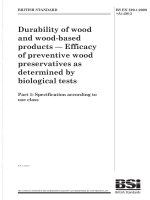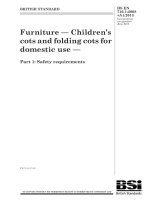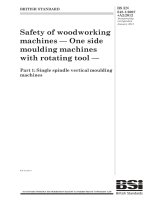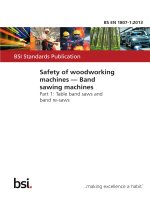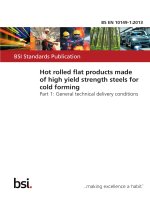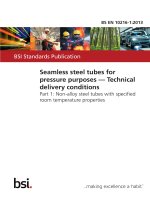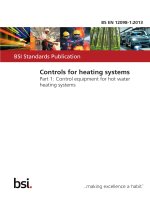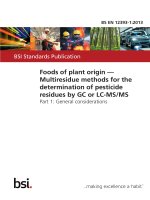Bsi bs en 01860 1 2013
Bạn đang xem bản rút gọn của tài liệu. Xem và tải ngay bản đầy đủ của tài liệu tại đây (1.57 MB, 36 trang )
BS EN 1860-1:2013
BSI Standards Publication
Appliances, solid fuels
and firelighters for
barbecueing
Part 1: Barbecues burning solid fuels —
Requirements and test methods
BS EN 1860-1:2013
BRITISH STANDARD
National foreword
This British Standard is the UK implementation of EN 1860-1:2013. It
supersedes BS EN 1860-1:2003 which is withdrawn.
The UK participation in its preparation was entrusted by Technical
Committee RHE/28, Domestic solid mineral fuel appliances, to
Subcommittee RHE/28/1, Appliances, solid fuels and firestarters for
barbecuing.
The UK committee voted against approval of this European Standard
due to the absence of a product labelling requirement that adequately
highlights the risk of fatal carbon monoxide poisoning that can be
posed by use of these products. EN 1860-1 will shortly be amended by
CEN to address this and it has been requested by the committee to issue
similar amendments to EN 1860-2, EN 1860-3 and EN 1860-4. However in
regard to concerns in the UK relating to incidences of carbon monoxide
poisoning please refer to the National Annex for best practice guidance.
National Annex NA (informative), found at the end of this document,
offers recommendations for the marking of products made in
accordance with 1860-1.
A list of organizations represented on this subcommittee can be
obtained on request to its secretary.
This publication does not purport to include all the necessary provisions
of a contract. Users are responsible for its correct application.
© The British Standards Institution 2014.
Published by BSI Standards Limited 2014
ISBN 978 0 580 77058 6
ICS 75.160.10; 97.040.20
Compliance with a British Standard cannot confer immunity from
legal obligations.
This British Standard was published under the authority of the Standards
Policy and Strategy Committee on 30 April 2014.
Amendments/corrigenda issued since publication
Date
Text affected
BS EN 1860-1:2013
EN 1860-1
EUROPEAN STANDARD
NORME EUROPÉENNE
EUROPÄISCHE NORM
January 2013
ICS 75.160.10; 97.040.20
Supersedes EN 1860-1:2003
English Version
Appliances, solid fuels and firelighters for barbecueing - Part 1:
Barbecues burning solid fuels - Requirements and test methods
Appareils, combustibles solides et allume-feu pour la
cuisson au barbecue - Partie 1: Barbecues utilisant les
combustibles solides - Exigences et méthodes d'essai
Geräte, feste Brennstoffe und Anzündhilfen zum Grillen Teil 1: Grillgeräte für feste Brennstoffe - Anforderungen und
Prüfverfahren
This European Standard was approved by CEN on 16 September 2012.
CEN members are bound to comply with the CEN/CENELEC Internal Regulations which stipulate the conditions for giving this European
Standard the status of a national standard without any alteration. Up-to-date lists and bibliographical references concerning such national
standards may be obtained on application to the CEN-CENELEC Management Centre or to any CEN member.
This European Standard exists in three official versions (English, French, German). A version in any other language made by translation
under the responsibility of a CEN member into its own language and notified to the CEN-CENELEC Management Centre has the same
status as the official versions.
CEN members are the national standards bodies of Austria, Belgium, Bulgaria, Croatia, Cyprus, Czech Republic, Denmark, Estonia,
Finland, Former Yugoslav Republic of Macedonia, France, Germany, Greece, Hungary, Iceland, Ireland, Italy, Latvia, Lithuania,
Luxembourg, Malta, Netherlands, Norway, Poland, Portugal, Romania, Slovakia, Slovenia, Spain, Sweden, Switzerland, Turkey and United
Kingdom.
EUROPEAN COMMITTEE FOR STANDARDIZATION
COMITÉ EUROPÉEN DE NORMALISATION
EUROPÄISCHES KOMITEE FÜR NORMUNG
Management Centre: Avenue Marnix 17, B-1000 Brussels
© 2013 CEN
All rights of exploitation in any form and by any means reserved
worldwide for CEN national Members.
Ref. No. EN 1860-1:2013: E
BS EN 1860-1:2013
EN 1860-1:2013 (E)
Contents
Page
Foreword ..............................................................................................................................................................3
Introduction .........................................................................................................................................................4
1
Scope ......................................................................................................................................................5
2
Normative references ............................................................................................................................5
3
Terms and definitions ...........................................................................................................................5
4
4.1
4.2
4.2.1
4.2.2
4.2.3
4.2.4
4.2.5
4.2.6
4.2.7
4.2.8
Requirements .........................................................................................................................................7
General requirements ............................................................................................................................7
Requirements for parts .........................................................................................................................8
Cooking grid ...........................................................................................................................................8
Rotisserie spit ........................................................................................................................................9
Fuel compartment ..................................................................................................................................9
Ash compartment or catcher ............................................................................................................. 11
Gravy tray or drip pan ........................................................................................................................ 12
Stand .................................................................................................................................................... 12
Handles or gripping devices .............................................................................................................. 12
Motor .................................................................................................................................................... 14
5
5.1
5.2
5.2.1
5.2.2
5.2.3
5.3
5.4
5.4.1
5.4.2
5.5
5.6
5.7
Test methods....................................................................................................................................... 14
General ................................................................................................................................................. 14
Thermal test ......................................................................................................................................... 14
General ................................................................................................................................................. 14
Thermal test of use ............................................................................................................................. 14
Safety test ............................................................................................................................................ 17
Combustibility ..................................................................................................................................... 18
Stability ................................................................................................................................................ 18
Barbecues and suitcase barbecues.................................................................................................. 18
Permanent barbecues ........................................................................................................................ 18
Handling ............................................................................................................................................... 20
Cooking grid ........................................................................................................................................ 20
Perforation test ................................................................................................................................... 21
6
Marking ................................................................................................................................................ 23
7
Instructions for use ............................................................................................................................ 23
Annex A (informative) Mandatory sentences ................................................................................................ 25
Bibliography ..................................................................................................................................................... 31
2
BS EN 1860-1:2013
EN 1860-1:2013 (E)
Foreword
This document (EN 1860-1:2013) has been prepared by Technical Committee CEN/TC 281 “Appliances, solid
fuels and firelighters for barbecuing”, the secretariat of which is held by AENOR.
This European Standard shall be given the status of a national standard, either by publication of an identical
text or by endorsement, at the latest by July 2013, and conflicting national standards shall be withdrawn at the
latest by January 2014.
Attention is drawn to the possibility that some of the elements of this document may be the subject of patent
rights. CEN [and/or CENELEC] shall not be held responsible for identifying any or all such patent rights.
This document supersedes EN 1860-1:2003.
The main technical modifications are the following:
a.
b.
c.
d.
e.
f.
Clause 3, Terms and definitions: definition of BBQ modified to introduce Close and Open barbecues;
4.2.3.1: measurement of thickness added;
New 4.2.4, Ash compartment or catcher;
4.2.7: Table 3 modified;
Clause 5, Test Methods: Test methods modified. A thermal test of use and a safety test were added;
New Annex A.
This European Standard on appliances, solid fuels and firelighters for barbecuing consists of the following
parts:
Part 1: Barbecues burning solid fuels — Requirements and test methods
Part 2: Barbecue charcoal and barbecue charcoal briquettes — Requirements and test methods
Part 3: Firelighters for igniting solid fuels for use in barbecue appliances — Requirements and test methods
Part 4: Single use barbecues burning solid fuels — Requirements and test methods
According to the CEN/CENELEC Internal Regulations, the national standards organisations of the following
countries are bound to implement this European Standard: Austria, Belgium, Bulgaria, Croatia, Cyprus, Czech
Republic, Denmark, Estonia, Finland, Former Yugoslav Republic of Macedonia, France, Germany, Greece,
Hungary, Iceland, Ireland, Italy, Latvia, Lithuania, Luxembourg, Malta, Netherlands, Norway, Poland, Portugal,
Romania, Slovakia, Slovenia, Spain, Sweden, Switzerland, Turkey and the United Kingdom.
3
BS EN 1860-1:2013
EN 1860-1:2013 (E)
Introduction
This standard is part 1 of the European Standard for appliances, solid fuels and firelighters for barbecuing,
which is intended to reduce the risks which can occur during and through barbecuing with solid fuels.
This part should be read in conjunction with parts 2 and 3.
4
BS EN 1860-1:2013
EN 1860-1:2013 (E)
1
Scope
This part of this European Standard is applicable to barbecues which burn solid fuels, except single use
barbecues. Barbecues which are intended to be converted from other fuels to solid fuels also should conform
to this standard.
This European Standard specifies requirements for materials, construction, design, test methods, markings
and instructions relating to them.
2
Normative references
The following documents, in whole or in part, are normatively referenced in this document and are
indispensable for its application. For dated references, only the edition cited applies. For undated references,
the latest edition of the referenced document (including any amendments) applies.
EN 1860-2, Appliances, solid fuels and firelighters for barbecuing — Part 2: Barbecue charcoal and barbecue
charcoal briquettes — Requirements and test methods
3
Terms and definitions
For the purposes of this document, the following terms and definitions apply.
3.1
barbecue
appliance designed for outdoor cooking in the open air which is divided into the following categories
3.1.1
suitcase barbecue or portable barbecue
appliance that can be carried with one hand without parts falling of when dismantled or folded. It can be
classified as either:
a)
closed as described in 3.1.2 or;
b)
open as described in 3.1.3
3.1.2
closed barbecue
appliance designed for cooking outdoors by means of radiant and convection heat consisting at least of a fuel
compartment, a lid which may have air vents, a cooking grid and/or a rotisserie
3.1.3
open barbecue
appliance designed for cooking outdoors by means of radiant heat consisting at least of a fuel compartment, a
cooking grid and/or a rotisserie
5
BS EN 1860-1:2013
EN 1860-1:2013 (E)
3.1.4
permanent barbecue
outdoor barbecue designed to be permanently installed. It may consist of pre-fabricated elements fitted
together and may include a pre-fabricated hood. It may have removable parts, and be classified as either:
a)
closed as described in 3.1.2 or;
b)
open as described in 3.1.3
3.2
fuel compartment
part of the barbecue where the fuel is burnt; it may have, or be a fuel grate and may have air vents. In closed
barbecues the fuel compartment is the fuel grate or the fuel grate with fuel rails or baskets or a fuel tray
3.3
fuel grate
perforated part of the barbecue on which the fuel is placed
3.4
ash compartment or catcher
part of the barbecue intended to catch any ash or embers which may fall from the fuel compartment or fuel
grate
3.5
barbecue accessories
parts of the barbecue which hold the food to be barbecued during cooking
3.5.1
cooking grid
part of the barbecue on which the food to be cooked is placed and/or which can take on the function of the
fuel grate
3.5.2
rotisserie spit
metal rod suitable for skewering the food to be cooked via the truncated cone on one side and which can be
rotated by hand and/or via a motor in a suitable support
3.5.3
rotisserie meat forks
clamping devices on the rotisserie spit that can be slid onto and fixed in any position on which the food to be
cooked can be secured
3.5.4
gravy tray
device to collect juices and drippings to be consumed
3.6
removable parts
parts which can be removed without the use of a tool
3.7
usable area
any area of a barbecue component and accessories, as described in 3.5 through 3.5.4, intended to come into
contact with the food to be barbecued during cooking is regarded as being usable
3.8
drip pan
device to collect waste drippings not to be consumed
6
BS EN 1860-1:2013
EN 1860-1:2013 (E)
3.9
stand
support structure of a barbecue onto which the functional parts of the barbecue are located
3.10
silk paper
2
2
thin, soft, relatively hard to tear paper with a weight between 12 g/m and 25 g/m usually used to wrap
delicate objects
3.11
windshield
component of the barbecue used to minimise undesirable effect of the wind during the use of the barbecue
4
4.1
Requirements
General requirements
When testing as described in 5.2, the coatings of the barbecue accessories shall not liberate any solid
substance nor ignite. Also any solid substance coming from other parts of the barbecue shall not ignite nor fall
into the usable area.
NOTE
For surfaces of and coatings on parts of the barbecue coming into contact with the food to be barbecued,
cooking grid, rotisserie spit, rotisserie meat forks and gravy trays, see Regulation (EC) No 1935/2004 (see Bibliography).
Differing legal requirements may exist in non-EU-countries.
It shall be possible to assemble and dismantle suitcase or portable barbecues as described in the instructions
for use either without the aid of a tool or using the tool that is supplied. Components shall be fixed in such a
way that they cannot fall off during transportation.
When assembling, operating and manipulating the barbecue, accessible edges and corners shall be free from
burr. Rough surfaces, sharp edges and corners, which can cause injury, are not allowed.
In case of doubt to determine whether rough surface, sharp edges or corners can cause an injury a test
according to EN 71-1:2009, 8.11 is mandatory.
All accessible parts of the barbecue components made of metal sheet or tubes of thickness less than 0,7 mm
(– 0,02 mm) coating excluded shall be as shown in Figures 1, 2, 3 and 4.
Figure 1 — Fully edged
Figure 2 — Folded and flattened
7
BS EN 1860-1:2013
EN 1860-1:2013 (E)
Figure 3 — Rolled and closed
Figure 4 — Rolled and half closed
The construction of the barbecue shall be such that when placed horizontally the change of the fuel
compartment position, according to the instruction for use and the insertion and removal of barbecue
accessories with the cooking grid and/or rotisserie spit loaded as described in 5.5, shall be possible without
the barbecue tipping over or components becoming detached or moved in such a way that they are no longer
capable of fulfilling their functions. These requirements also apply when testing the barbecue as described
in 5.2.
After testing in accordance with Clause 5, a barbecue fails if it does not meet the following requirements:
a)
any deformation of a component that compromises the use and safety of the barbecue;
b)
any component showing cracks and/or fractures;
NOTE
A permanent barbecue may show cracks and/or fractures which do not influence the safety.
c)
any component falls off;
d)
the temperature and safety requirements mentioned in the test descriptions are not met.
4.2
4.2.1
Requirements for parts
Cooking grid
The clear distance between the bars of the cooking grid shall not exceed 20 mm before, during and after
testing according to 5.2 and 5.6. This requirement relates to the usable area of the grid, which shall be at
least 80 % of the horizontal area of the fuel compartment, vertically projected.
If the cooking grid has the function of a grate, the clear distance between the bars of the grate and also, in the
case of vertical fuel compartment, of those between the grate and the edges of the fuel container shall not
exceed 20 mm before, during and after testing according to 5.2 and 5.6.
8
BS EN 1860-1:2013
EN 1860-1:2013 (E)
The cooking grid shall rest on its supporting points in the most unfavourable position when loaded as
described in 5.5. When the load has been removed the deformation of each grid bar shall not exceed 5 %
relative to the length of the bar when tested according to 5.6.
Manually adjustable cooking grids up to 400 mm diameter or longest side measurement shall be fitted with
one handle minimum, cooking grids over 400 mm diameter or longest side measurement shall be fitted with
two handles. If the cooking grid position is adjustable, this adjustment shall be possible without the operator's
hand coming into direct contact with the cooking grid.
Removable or movable handles shall be attached to the cooking grid in such a way that tipping to the side or
forwards when loaded as described in 5.5 shall be impossible.
Handle is not required when the height of the cooking grid can be adjusted through a mechanical device.
The barbecue shall be designed in such a way that when the fuel compartment is uniformly loaded to 75 % of
its capacity, the cooking grid in its most unfavourable position shall not come into contact with the fuel.
4.2.2
Rotisserie spit
The end of the rotisserie spit shall have the shape of a truncated cone of minimum diameter not less
than 1,5 mm and not exceeding 3 mm and a taper angle between 60° and 90°.
The rotisserie spit shall have a permanent or removable handle of at least 100 mm usable length.
The handle for any motor supplied with it shall be 80 mm minimum length.
If the distance between the support points of the rotisserie spit exceeds 800 mm a second handle shall be
provided unless the motor has the function of a handle.
The handle (or handles) shall be fitted to the rotisserie spit in such a way that when tested in accordance
with 5.2.2 the surface temperatures shall not exceed the values specified in Table 3.
The rotisserie spit shall have a minimum of two adjustable and fixable rotisserie meat forks.
When loading the rotisserie spit with 0,5 kg per 100 mm usable length it shall rest on all its supporting points.
The other components of the barbecue or the fuel load following the instructions for use shall not come into
contact with a cylinder 200 mm in diameter and of a length equivalent to at least 60 % of the usable rotisserie
spit length placed centrally around the rotisserie spit and in the centre of the rotisserie spit. If several rotisserie
spit positions are possible, this requirement shall be met for at least one position.
4.2.3
4.2.3.1
Fuel compartment
General
Fuel compartments made of steel sheet require a minimum thickness (coating excluded) as specified in
Table 1.
The thickness shall be measured in three different points:
one to be in the centre of the bottom;
two on the opposite sides at minimum 150 mm from each other;
If one side of the fuel compartment is a grate, only two sides are measured.
9
BS EN 1860-1:2013
EN 1860-1:2013 (E)
The thickness shall be considered the average of the measurements.
NOTE
On finished products ready to be commercialised:
1)
Measure the total thickness “Tt” in the three points of the fuel compartment.
2)
Measure at these same points on both sides the thickness of the coating Cext and Cint.
3)
Calculate by subtraction the thickness of the uncoated steel sheet in each. T = Tt – (Cext + Cint)
4)
Calculate the average from them.
Table 1 — Minimum thickness of steel sheet for fuel compartments
Grid size diameter or longest side
measurement
Thickness
≤ 400 mm
0,7 mm
> 400 mm
0,8 mm
For fuel compartments with a grid size diameter or longest side measurement ≤ 400 mm, a thickness (coating
excluded) between 0,5 mm and 0,7 mm is acceptable, provided they are glass or porcelain enamelled on both
sides and withstand the tests according to:
a) 5.2.2 one time and 5.2.3 two times consecutively; and
b) 5.7.
Fuel compartments made of cast metal require a minimum thickness coating excluded of 2,5 mm.
Fuel compartments made of materials other than steel sheet or cast material (excluding permanent
barbecues) shall withstand the tests according to:
a) 5.2.2 one time and 5.2.3 two times consecutively; and
b) 5.7.
4.2.3.2
Openings
If the fuel compartment after assembly has openings, these shall meet the following requirements when tested
as described in 5.2 and 5.3.
The number of openings in the flat base of the fuel compartment shall not exceed four and shall be
dimensioned so that a sphere of 3 mm in diameter will not fall through them, their area shall not
2
exceed 50 mm .
Other openings, other than in the flat base, if circular should have a diameter not exceeding 8 mm, or, if a
2
different shape, their area shall not exceed 50 mm .
With larger openings the barbecue shall be equipped with an ash catcher or the barbecue shall be designed
so that it is impossible for any embers or fuel to fall out or roll off when tested as described in 5.2 and 5.3.
4.2.3.3
Depth of the fuel compartment
The minimum depth of the fuel compartment shall be as indicated in Table 2. The minimum depth shall be
available over 80 % of the usable area of the fuel compartment.
10
BS EN 1860-1:2013
EN 1860-1:2013 (E)
Table 2 — Minimum depth of the fuel compartment
Grid size diameter or longest side
measurement
Minimum depth of fuel compartment
≤ 400 mm
50 mm
> 400 mm
60 mm
If the fuel compartment is a grate Table 2 shall not be taken into account but it shall have an ash catcher.
If the fuel compartment has several possible positions, stops shall be provided to secure it in each of these
positions.
For permanent barbecues part of the structure can be used as the fuel compartment when calculating the
minimum depth shown in Table 2.
For the permanent barbecue the front side of the fuel compartment can be open if it’s protected by a flat
protection plane minimum 130 mm deep to prevent embers from falling to the ground as shown in Figure 5.
Dimensions in millimetres
Keys
A
B
fuel compartment
flat protection plane
Figure 5 — Top view of flat protection plane for permanent barbecue
4.2.4
Ash compartment or catcher
Ash compartments or catcher made of sheet metal require a minimum thickness (coating excluded) of 0,7
mm.
For ash compartments or catchers with a diameter or longest side measurement ≤ 400 mm, a thickness
(coating excluded) between 0,5 mm and 0,7 mm is acceptable, provided they are glass or porcelain
enamelled on both sides.
11
BS EN 1860-1:2013
EN 1860-1:2013 (E)
4.2.5
Gravy tray or drip pan
If the barbecue has a gravy tray or drip pan with the barbecue in the horizontal position it shall either be
arranged in such a way that its contents flow away from the fuel compartment or have a recess at least 5 mm
deep and the horizontal distance between the grate and the beginning of the recess shall be at least 30 mm,
when the base of the gravy tray or drip pan is horizontal.
4.2.6
Stand
If the stand is foldable, the folding elements shall be capable of being locked in the operating position of the
barbecue. A locking and/or unlocking device shall not operate unintentionally.
The stand shall support the barbecue when tested in any position as described in 5.4. The barbecue shall not
tip over and when used in accordance with the instructions for use no components shall fall off.
If the stand or barbecue has wheels or castors to enable it to be moved:
a)
no parts or accessories shall fall off during movement;
b)
means shall be provided to prevent accidental movement of the stand or barbecue during normal use;
This requirement is satisfied if:
at least one of the wheels or castors is fitted with a brake or a blocking system; or
at least one of the support points of the barbecue is not made of a wheel or a castor;
c)
a gripping device shall be provided to move the barbecue safely while cold.
4.2.7
Handles or gripping devices
Lid and adjustable cooking grid handles shall have a usable length of minimum 80 mm. Separate
requirements apply for rotisserie spit handles (see 4.2.2).
The temperature shall be taken only of lid and adjustable cooking grid handles which are needed during
operation of the barbecue.
The temperature of all other handles or gripping devices (e.g. air control of lid, ash tray or non adjustable
cooking grid) shall not be taken if the manufacturer clearly states the use of mitts, gloves or a tool in the
instructions for use (e.g. pictogram or a sentence).
The surface temperatures over the full usable part of the handle or gripping device shall not exceed the values
specified in Table 3 when tested in accordance with 5.2.2. In case of handles uniform in shape and longer
than 80 mm, temperatures shall be measured as shown in Figures 6 and 7.
Table 3 — Surface temperatures over ambient temperature
Material
12
Temperature
Metal
35 K
Glass/ceramics
45 K
Plastics
60 K
Wood
70 K
BS EN 1860-1:2013
EN 1860-1:2013 (E)
Key
1
80 mm usable area
Figure 6 — Example of useful parts of gripping area for cooking grid handles
Key
1
80 mm usable area
Figure 7 — Example of useful parts of gripping area for cooking grid handles
13
BS EN 1860-1:2013
EN 1860-1:2013 (E)
4.2.8
Motor
For a barbecue supplied with a motor with spring winding or battery operated, or if the use of a specific motor
is permitted by the instructions for use, the following shall apply:
the motor shall operate the rotisserie spit for at least 30 min without having to rewind the motor or replace
the batteries;
there shall be no risk, when rewinding the motor or replacing the batteries of the operators hand coming
into contact with other part of the barbecue with surface temperatures exceeding the values specified
in Table 3.
This requirement applies for the rotisserie spit loaded as described in 4.2.2.
The motors supplied shall still be capable of moving the rotisserie spit loaded as described in 4.2.2 after
testing in accordance with 5.2.
5
Test methods
5.1
General
The requirements given in Clause 4 shall be verified by visual examination, linear measurement, function
testing and/or calculation, unless otherwise specified.
Testing shall be carried out with charcoal/charcoal briquettes as defined in EN 1860-2.
Testing shall be carried out at an ambient temperature of (20 ± 5) °C, in still air (airspeed less than 0,5 m/s).
For testing purposes each individual weight shall not exceed 0,5 kg and 100 mm in any dimension.
5.2
Thermal test
5.2.1
General
The thermal test shall be performed in two parts.
For barbecues with several fuel compartments which may be operated separately or simultaneously, the test
shall be carried out in the most unfavourable combination.
If the fuel compartment or the compartments have several positions the testing shall be carried out in each
position.
After thermal tests verify whether the marking as specified in Clause 6 is still legible or has not come away.
5.2.2
5.2.2.1
Thermal test of use
General
The appliance, positioned is placed on a 25 mm thick wooden horizontal panel with the surface coated with
matt black paint as shown in Figures 8 and 9.
Thermocouple sensors are located in the panel at the centre of 200 mm squares, 3 mm from the surface of
the panel.
14
BS EN 1860-1:2013
EN 1860-1:2013 (E)
Dimensions in millimetres
Figure 8 — View of alternative thermocouple sensors positioning
Dimensions in millimetres
Figure 9 — Top view of thermocouple sensors positioning in a matt black painted surface
For permanent barbecues the temperature on the floor temperature measurement is not required and the
combustibility test shall be carried out as described in 5.3.
15
BS EN 1860-1:2013
EN 1860-1:2013 (E)
5.2.2.2
Closed barbecues
The barbecue shall be loaded with fuel according to manufacturers' instructions (quantity and kind of fuel). If,
there are several fuel load recommendations, the fuel load shall be done in the most unfavourable condition
for the heating of the handles of the cooking grid (which can be handled during cooking) and the horizontal
plane.
The fuel load shall produce an average temperature of 200 °C for a duration of 20 min (starting when the
centre has reached 200 °C) measured in one central point by thermocouple.
In this case the lid shall be closed according to manufacturer’s instruction.
In the case of utilisation of a rotisserie spit only, the temperature will be measured in three points centred on
the rotisserie spit and distant of 100 mm.
Handles temperature shall be taken by contact sensor only.
This measurement shall be taken as soon as the temperature of the cooking grid (previously described in this
subclause) will be at its maximum temperature.
Thermal tests shall comply:
with requirements of 4.2.7 for the handles;
the temperature of the horizontal plane, on which the barbecue is placed shall not exceed the ambient
temperature by more than 50 K.
5.2.2.3
Open barbecues
The fuel compartment of the barbecue shall be completely filled with lump charcoal according to EN 1860-2
up to the cooking grid in its lowest position.
This filling is removed from the fuel compartment and weighed.
Then 75 % of the weight is refilled into the fuel compartment and ignited.
Handles temperature shall be taken by contact sensor only.
Thermal tests shall comply:
with requirements of 4.2.7 for the handles;
the temperature of the horizontal plane, on which the barbecue is placed shall not exceed the ambient
temperature by more than 50 K.
5.2.2.4
Permanent barbecues
The barbecue shall be loaded with fuel according to manufacturers' instructions (quantity and kind of fuel).
If, there are several fuel load recommendations, the fuel load shall be done in the most unfavourable condition
for the heating of the handles of the cooking grid (which can be handled during cooking) and the horizontal
plane.
If wood and charcoal are both allowed the test shall be performed with charcoal.
Handles temperature shall be taken by contact sensor only.
16
BS EN 1860-1:2013
EN 1860-1:2013 (E)
This measurement shall be taken as soon as the temperature of the cooking grid (previously described in this
subclause) will be at its maximum temperature.
Thermal tests shall comply:
with requirements of 4.2.7 for the handles;
the paper in accordance with combustibility test in 5.3 shall not catch fire (small holes are allowed) and
the plywood shall not become singed.
In case of closed permanent barbecue only, the fuel load shall produce an average temperature of 200 °C for
a duration of 20 min (starting when the centre has reached 200 °C) measured in one central point by
thermocouple. In this case the lid shall be closed according to manufacturer’s instruction. Handles
temperature shall be taken as soon as the temperature of the cooking grid (previously described in this
subclause) will be at its maximum temperature. In the case of utilisation of a rotisserie spit only, the
temperature will be measured in three points centred on the rotisserie spit and distant of 100 mm.
5.2.3
5.2.3.1
Safety test
Closed barbecues
The fuel compartment shall be completely filled with lump charcoal according to EN 1860-2 up to the cooking
grid in its lowest position.
This filling is removed from the fuel compartment and weighed.
Then 75 % of the weight is refilled into the fuel compartment and ignited.
The test is performed without lid and cooking grid.
The fuel is then allowed to burn completely to ashes and then removed.
The test is repeated one time while performing the combustibility test according to 5.3.
After these two tests, the barbecue is visually examined for deformation, charring or the structure becoming
loose and to ensure that all components still fit. The requirements of 4.1 a), b) and c) shall be verified.
The barbecue is placed on a 10° inclined plane and filled as described in 5.4.
The barbecue shall remain stable and all components shall stay in place.
5.2.3.2
Open barbecues
The fuel compartment shall be completely filled with lump charcoal according to EN 1860-2 up to the cooking
grid in its lowest position.
This filling is removed from the fuel compartment and weighed.
Then 75 % of the weight is refilled into the fuel compartment and ignited.
The test is performed without cooking grid.
The test is performed while doing the combustibility test according to 5.3.
The fuel is then allowed to burn completely to ashes and then removed.
After this test, the barbecue is visually examined for deformation, charring or the structure becoming loose
and to ensure that all components still fit. The requirements of 4.1 a), b) and c) shall be verified.
17
BS EN 1860-1:2013
EN 1860-1:2013 (E)
The barbecue is placed on a 10° inclined plane and filled as described in 5.4.
The barbecue shall remain stable and all components shall stay in place.
5.2.3.3
Permanent barbecues
The test shall be carried out with two consecutive loads of fir timber with a moisture content of (20 ± 4) % cut
to listels of section (50 ± 5) mm × (50 ± 5) mm and the same length as the fuel compartment and placed in
such a way as to form one layer with a distance of 10 mm between adjacent listels covering the complete
surface of the fuel compartment.
The second load shall be 50 % in volume of the first load and shall be loaded not later than 30 min after the
first lighting. Operate the barbecue until both loads are burnt completely.
After these two tests, the barbecue is visually examined to ensure that all components still fit. Eventual cracks
and fractures appeared during tests shall not influence the usability and the general safety of the barbecue.
The requirements of 4.1 a), b) and c) shall be verified.
5.3
Combustibility
The barbecue shall be placed on a plywood plane of natural colour additionally closed with white silk paper in
accordance with 3.10, and loaded and operated as described in 5.2.3.
The size of the test area shall correspond to the barbecue installation area, plus a margin of 250 mm all
round. During the test the paper shall not catch fire (small holes are allowed) and the plywood shall not
become singed.
5.4
Stability
5.4.1
Barbecues and suitcase barbecues
The barbecue is placed on a plane made of plywood at an angle of 10° to the horizontal. To prevent the
barbecue from slipping or rotating, it may be stopped at the contact points without restricting the possibility of
tipping over. The barbecue shall not tip over in any of the most unfavourable positions and conditions for use
when loaded as described in 5.2.2 and the rotisserie spit loaded as described in 4.2.2.
Then the barbecue shall be placed on a horizontal plane with the fuel compartment loaded as described
2
in 5.2.2 and the cooking grid loaded with a charge of 1 kg/dm of the usable area of the cooking grid uniformly
distributed.
During these two tests the requirements of 4.1 a), b) and c) shall be verified by visual examination and linear
measurement.
5.4.2
5.4.2.1
Permanent barbecues
Permanent barbecues with hood
The stability test shall be an impact resistance test carried out according to Figure 10, with the impact point in
the central rear part at 1,3 m from the horizontal base, a drop height of 1,0 m and using a spheroconical bag
according to Figure 11. The mass of the spheroconical bag shall be 10 % of the total mass of the barbecue
with a maximum of 50 kg. The barbecue shall be built according to the instructions for installation and use.
In the mass evaluation the prefabricated elements not structurally fitted (e.g. a bench) shall be excluded.
During this test the requirements of 4.1 a), b) and c) shall be verified by visual examination and linear
measurement.
18
BS EN 1860-1:2013
EN 1860-1:2013 (E)
5.4.2.2
Permanent barbecues without hood
The permanent barbecue without hood shall be tested according to 5.4.1.
Dimensions in millimetres
Key
1
2
pulley
winch
5
6
drop height
rear of the permanent barbecue
3
4
cable
length
7
8
horizontal surface
snap-hook releasable from a distance
Figure 10 — Stability test
19
BS EN 1860-1:2013
EN 1860-1:2013 (E)
Dimensions in millimetres
Filled closed bag
Empty open bag
Key
1
2
leather string
eight canvas sections
3
leather bottom
Figure 11 — Spheroconical bag for the stability test
5.5
Handling
The barbecue is placed as described in 5.2:
2
a)
The cooking grid is loaded with 0,25 kg/dm uniformly distributed over the usable area;
b)
The rotisserie spit is loaded with 0,5 kg/dm usable length, uniformly distributed.
It shall be verified that barbecue accessories can be inserted or removed and the position of the fuel
compartment can be changed, as described in the instructions for use.
5.6
Cooking grid
The barbecue is placed as described in 5.2. After testing in accordance to 5.2.2, the cooking grid is loaded
2
with 0,5 kg/dm of the usable area. The load shall be removed after one minute.
A permanent deformation of each cooking grid bar shall be measured and shall comply with 4.2.1.
20
BS EN 1860-1:2013
EN 1860-1:2013 (E)
5.7
Perforation test
Using the arrangement shown in Figure 12, the test object is placed on a horizontal solid steel support of
minimum 10 mm thickness.
The guide tube shall be placed vertically above the test object on the centre line of the 20 mm diameter hole.
Position the test weight in the top of the tube with the point 1 m above the test object. The test weight is
allowed to fall by gravity onto the test object.
The test fails if the test object is perforated.
This subclause should be read in conjunction with 4.2.3.1.
21
BS EN 1860-1:2013
EN 1860-1:2013 (E)
Dimensions in millimetres
Key
1
2
weight 700 g ± 1 %
marking
5
6
solid steel support 10 mm × 100 mm × 200 mm
test object
3
4
point hardened
pipe
7
8
solid bottom
free fall
Figure 12 — Perforation test by gravity
22
BS EN 1860-1:2013
EN 1860-1:2013 (E)
6
Marking
Markings shall be visible, legible, indelible and at least in the national language(s) of the country of sale.
The barbecue shall be marked with the following information:
a)
Name or trademark of the manufacturer or distributor. This shall be fitted on the barbecue by casting,
stamping, enamelling or labelling;
b)
Warning notice
" WARNING! Do not use spirit or petrol for lighting or re-lighting!"
This warning notice shall still be legible and shall not have come off after testing in accordance with 5.2.
The size of the lettering shall be at least 3 mm for upper case letters and 2 mm for lower case letters in
contrast with the background and shall be visible during the operation of the barbecue.
c)
Model or type designation. This marking may be on the packaging only.
7
Instructions for use
The instructions for use shall be given at least in the national language(s) of the country of sale. They shall
contain at least the following information and shall be supplied with each barbecue:
a)
the model or type designation including exploded view and parts list;
b)
the statement that the barbecue has to be installed on a secure level base prior to use;
c)
the method of correct assembly possibly using illustrations;
d)
advice on the safe operation of the barbecue;
e)
the recommendation that the barbecue shall be heated up and the fuel kept red hot for at least 30 min
prior to the first cooking;
f)
the recommended fuel(s) and the maximum amount to be used specified by the manufacturer;
g)
the correct lighting procedures including the statement "do not cook before the fuel has a coating of
ash";
h)
the type of batteries to be used if a battery powered electric item (for example motor, blower, light ) is
supplied or specified;
i)
the type of bonding agent if required for construction of permanent barbecues;
j)
the following warning notices:
•
for open and closed barbecues:
" WARNING! This barbecue will become very hot, do not move it during operation"
"Do not use indoors!"
" WARNING! Do not use spirit or petrol for lighting or re-lighting! Use only firelighters complying to
EN 1860-3!"
"WARNING! Keep children and pets away"
23
